Nail Product lifting, in the context of nail care, refers to the separation or detachment of nail products, such as acrylic or gel enhancements, from the natural nail. This issue occurs when the applied nail product loses its adhesion to the natural nail, leading to gaps between the product and the natural nail or even complete detachment.
Product lifting can manifest in various ways, ranging from subtle gaps at the back of the nail (PNF) to extensive lifting of the entire nail enhancement. It can be a frustrating and disheartening experience for both clients and nail technicians, as it undermines the efforts put into creating beautiful and durable nail designs.
This phenomenon can be caused by a combination of factors, including improper nail preparation, incorrect application techniques, curing product that is touching the skin, allergic reactions to the products, and external environmental influences.
Compreender as causas do levantamento de produtos Nail é fundamental para evitar sua ocorrência e para lidar com ele de forma eficaz quando isso acontecer.
Nas seções a seguir, exploraremos os fatores que contribuem para o levantamento do produto, os sinais e sintomas comuns que devem ser observados e as etapas a serem seguidas para prevenir e gerenciar esse problema, garantindo que os aprimoramentos das unhas permaneçam impressionantes e duradouros.
Entendendo o levantamento de produtos para unhas
To effectively address and prevent product lifting in nail enhancements, it’s essential to grasp the underlying mechanics and contributing factors. By gaining a deeper understanding of why product lifting occurs, nail technicians can implement strategies to enhance adhesion and provide clients with enduring, flawless nails.
O que é Lifting de produtos para unhas?
Product lifting occurs when the bond between the nail enhancement product (such as acrylic, gel, gelpolish or dip powder) and the natural nail bed weakens or breaks. This separation leads to gaps, air pockets, or complete detachment of the enhancement from the natural nail. Understanding the root causes of product lifting is pivotal in devising preventive measures and corrective actions.
Fatores que contribuem para a elevação de produtos para unhas:
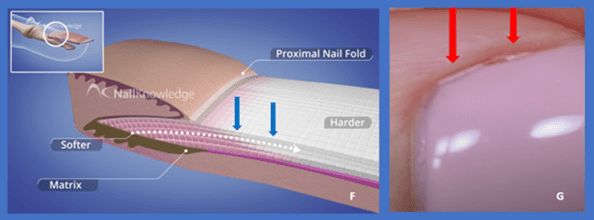
Touching any of the skin around the nail plate during product application This is one of the main problems we see, in the salon and at home, this will always cause ‘lifting’ because the nail plate is in perpetual motion 24/7 and the skin moves in the opposite direction, it sloofs off in a vertical direction this stops the product being sealed on the nail plate, water & oils get underneath and the nail enhancement lifts off of the nail plate, this tempts you or your client to pick at it and this in turn creates the perfect environment for pathogens to settle and reproduce and the recovery of that nail can take months!
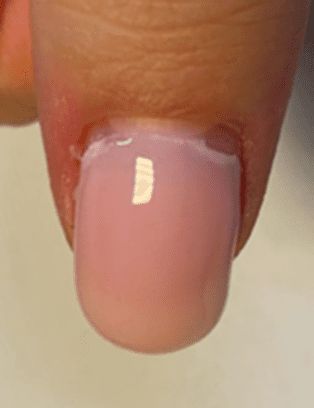
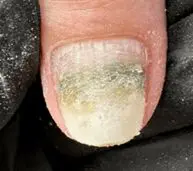
Vários outros fatores podem contribuir para a elevação do produto para unhas
- Preparação inadequada das unhas: A falta de preparação adequada da unha natural por meio de limpeza, desidratação e remoção do excesso de oleosidade pode prejudicar a adesão.
- Técnicas de aplicação incorretas: A aplicação de produtos para unhas com muita espessura, de forma desigual ou apressada pode resultar em ar preso, má adesão e eventual levantamento.
- Reações alérgicas: Some clients might be allergic to certain chemicals present in nail products, causing irritation and lifting due to their body’s immune response.
- Mãos na água Using a hard nail products on weak nails that are always in water is detrimental to product adhesion because the nail plate is full of water it swells up & when this water evaporates the nail plate shrinks – this puts the product under continuous pressure –
- Ambiental Fatores: A exposição à umidade ou a outros elementos externos durante ou após a aplicação pode comprometer a ligação entre o aprimoramento e a unha natural.
- Formato e comprimento das unhas: As unhas com curvatura extrema ou comprimento excessivo podem sofrer maior estresse no reforço, levando ao levantamento.
Diferenciando o levantamento de produtos de outros problemas
It’s important to distinguish product lifting from other nail-related concerns, such as chipping, peeling, or breakage. Product lifting specifically refers to the detachment of the enhancement from the nail bed, while other issues might involve issues with the enhancement itself or the natural nail structure.
Ao compreender esses aspectos, os técnicos de unhas podem implementar estratégias preventivas durante os processos de preparação e aplicação das unhas. As seções subsequentes deste artigo se aprofundarão no reconhecimento dos sinais de elevação do produto, na compreensão de suas causas e na exploração de técnicas para prevenir e controlar esse problema de forma eficaz.
Nail Product lifting – Sounds Simple Enough, Right?
Mas o que causa isso?
- Cutícula na placa ungueal
- Óleo ou sujeira na placa ungueal
- Recontaminação da placa ungueal após a limpeza
- Uso excessivo de primer
- Incorrect use of base coat
- Produto não curado
- Placa ungueal instável
a. roedor de unhas
b. placa ungueal lixada muito fina - Roedores de unhas
a. Placa ungueal insuficiente para colocar o produto
b. Uso de dicas - Incorrect size and fit of artificial nail tips
a. Old glue - Colocação incorreta do formulário
a. Prego plano, colocação de forma curva
b. Prego curvo, colocação de forma plana - Contato do produto com a pele durante a aplicação
- Incorrect mix ratio L&P
a. Aplicação irregular
i. Deixar as soleiras das portas no PNF
ii. Product running into the lateral nail folds - Não usar o sistema correto para o tipo específico de unha
- Levantamento de bolso
a. Trauma
b. Beliscão
c. Fraqueza da placa ungueal - Nail plate affected by Hyperhidrosis (Commonly affected areas include the: armpits. palms of your hands, possibly nail units)
- Placing product underneath the eponychium (after excessive efile manicure)
- Sistemas de mistura
Let’s have a Look at them in More Detail
Cutícula na placa ungueal
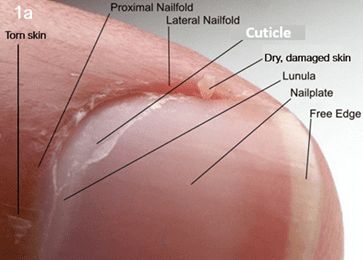
A cutícula é feito de tecido elástico não vivo e fica preso ao placa ungueal cells as they come through the eponychium. It is one of the four guardian seals. It protects the nail matrix from pathogens that we come across in our daily lives, and that’s a good thing. However, when it comes to our artificial nail products, it can cause real problems. We need to remove it com cuidado! It doesn’t need aggressive removal with a drill bit rotating at 20.000 RPM. If you think that’s ok, try it on the bonnet of your neighbor’s (new) car, and see what happens! Use your favorite good-quality nail oil & a curette, and you’re done in a couple of minutes.
Figura 2a shows a nail plate with cuticle on. There is no light reflection in the cuticle. We all work with lights so seeing it should be no problem. If you can’t see it, buy a loupe or some glasses 😊
Figura 2b shows a nail plate without cuticle – the light reflects through the whole length of the nail.
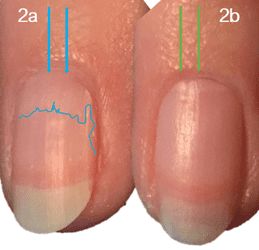
Óleo, minerais ou sujeira (ainda) na placa ungueal
Durante os lockdowns da Covid-19, ficamos todos entusiasmados com o fato de podermos voltar ao trabalho. Em muitos países, grupos de especialistas em unhas cederam seu tempo gratuitamente para ajudar os salões a encontrar maneiras de trabalhar seguindo práticas seguras. A prática de higiene era alta.
Washing hands with soap & water is one of the most effective ways to remove oil, minerals, and dirt from hands (feet) and nails. It takes almost no time at all – we should always do it, especially at the start of our service.
When you have finished removing the cuticle, and shaped the free edge with your file, let your client wash their hands novamente with soap, water, and a soft nail brush, dry them well, and continue with your favorite nail plate cleanser. 2 minutes now save 30 minutes of problem-solving in about a week’s time! Allow yourself those couple of minutes. I promise that you will be rewarded with much less product lifting – good for you, good for your client.
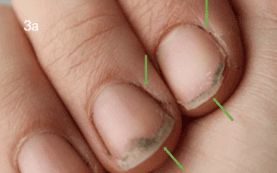
*Don’t forget, nail dust or dust from filing off artificial nail products can cause lifting problems at the free edge too! All the more reason for a quick wash after filing.
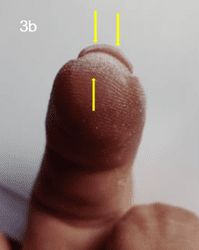
Recontaminação da placa ungueal após a limpeza
This is an interesting one that we don’t always realize is happening.
Sometimes working with artificial nail products takes time. Maybe you need to place forms and you’re not fast at that yet. Or the form got stuck on the nail plate. Maybe you are taking your time creating the right structure with a builder base coat. Whatever it may be, it does not matter. We don’t all work at the speed of light, and all of us work hard to improve our speed. Maybe our client is having an emotional day, maybe they rubbed their face after all your prep work. All these things can re-contaminate a nail plate after you have prepped it. If things take you a little longer, do one hand first. When it is complete, start the second hand. That way you greatly reduce the chances of it happening.
Uso excessivo de primer
Os primers têm uma função no mundo das unhas: eles ajudam a aderir os produtos às placas ungueais problemáticas. De fato, alguns produtos para unhas artificiais precisam deles para aderir adequadamente. Tudo começa com a condição da unha natural.
- Removing the upper layer of the nail plate before primer application will make the nail plate unstable & contribute to possible allergies.
- ALL primers contain acrylates or cyano-acrylates of some kind.
Os problemas se agravam se curarmos os primers de forma incorreta ou se os usarmos em excesso.
Alguns primers secam ao ar e outros são curados em uma estufa. Lâmpada UV/LED. Certifique-se de sempre ler as instruções do fabricante antes de usá-los.
Using too much primer or more than recommended, doesn’t improve adhesion:
- Inunda a placa ungueal, que fica muito úmida para a adesão adequada.
- Pode causar queimaduras.
- Contribui para as alergias.
Importante: If we remove the upper layers of the nail plate all of the time instead of just removing the shine, we start to place our product on the ‘unstable’ nail plate cells that are the middle layers of the nail plate. This will always result in product lifting.
Uso incorreto da camada de base
A Base Coat é a parte mais incompreendida e maltratada de nosso serviço de unhas. Mais importante ainda, é a parte mais importante de nosso serviço de unhas!
Deixe-me explicar:
The ONLY layer of your artificial nail product or nail coating, even nail varnish that touches the natural nail is the base coat.
Se a camada de base não aderir bem à unha natural, você poderá dizer adeus a todo o revestimento ou aprimoramento da unha nos próximos dias. O levantamento de produtos será inevitável.
In the beginning, Base Gels were high-adhesion, smooth, thin viscosity products.
Bons promotores de adesão são alguns dos componentes de base mais caros em nosso setor de unhas; se você adicioná-los a um gel de construção, você os perderá no processo. massa Portanto, se você usar um revestimento de base de construção multifuncional, será essencial usar um primer ou um adesivo.
Base Coat Gels are an efficient way to create maximum adhesion to the natural nail. In 2022, you can apply a high-quality base coat without roughing up or buffing the natural nail plate. Just using a high-quality nail plate cleanser will ensure that the integrity of the natural nail is maintained when artificial nail product coatings are used.
Some base coats achieve better adhesion if you use a primer or bonder – sometimes using a primer will also make the soak-off process easier. Some primers can and will extend the life of your soak-off product. It’s really important to not try and create your own recipe. Use the primer from the same company that provided your base coat.
Primers are specially formulated to match a system. Don’t be fooled into thinking the primer from company A will match the base coat from company B. You could end up cross-linking problem ingredients and end up with less adhesion instead of a better adhesion or, even worse, an allergy. Leave the chemistry to the chemists!
It’s important to realize that all base coats are composed differently. Some are made to soak off, and some are made to stay on the natural nail for longer. Be aware if you do a cosmetic pedicure that you will need a more durable base coat since your client is not likely to return to have her toenails done in 14 days.
Let’s recap:
- If your base coat needs to be cured for 10 seconds, don’t cure it for 30 seconds.
- Your color coat will only adhere to the base coat, control your base coat application – use your light to check that you have coated the entire nail plate.
- Use the color coat that matches the base coat. Otherwise, the inhibition layer in the base coat could adversely affect the color coat adhesion.
- Sempre cubra a borda livre da unha com a camada de base.
- Mantenha sua camada de base longe da pele.
- If your base coat has a nail life of 14 days – remove the product after 14 days, even if it looks good to the human eye the product will already be breaking down. Infections from White Superficial Onychomycosis or Pseudomonas Aeruginosa become a real possibility since both are part of our natural microbiomes (they already exist on our hands & feet)and are opportunistic. This means that, given the chance, they will develop in or on the natural nail plate.
- Sempre lave as mãos com água e sabão e seque bem antes da aplicação da camada de base (isso removerá a maioria dos agentes patogênicos da superfície, como WOS e PA)
- Do your PREP and or PEP according to the manufacturer’s instructions.
- Don’t rough up the nail plate with a file before applying your base coat, use a good quality nail plate cleanser instead, nail plate integrity is everything for a long-lasting service.
- If you want a longer-lasting base coat – buy one.
- Quando sua cliente tiver placas ungueais flexíveis, use um revestimento flexível para unhas também como camada de base.
- If your client has (open) beaded ridge nail plates a soak-off product might not be smart. Use a thin layer of Liquid & Powder that you can rebalance instead – or a thin layer of an Acrygel that you can rebalance – your client will thank you for it.
- If you want a soak-off product, make sure you soak it off in time and according to the manufacturer’s instructions. 10 mins = not 5 mins 😊 if your base coat adheres well to the natural nail, the only thing you will gain from saving 5 mins is 5 months of adhesion problems.
- Certifique-se de que você sabe o que o cliente espera que o revestimento ou o aprimoramento de suas unhas aguente e escolha a camada de base de acordo com as expectativas e o estilo de vida dele.
Produto não curado
Uncured product is a problem because we don’t often see the problem it can cause until later (24/48hrs later). Also, I have yet to meet a colleague that has x-ray vision! Sometimes it takes a few hours for the upper layer of your nail coating to collapse.
Let’s have a look at the problems that can occur from under-curing:
- Rugas e bolhas
- Descascamento
Rugas e bolhas: Geralmente acontece com cores escuras, preto, azul escuro, verde escuro etc.
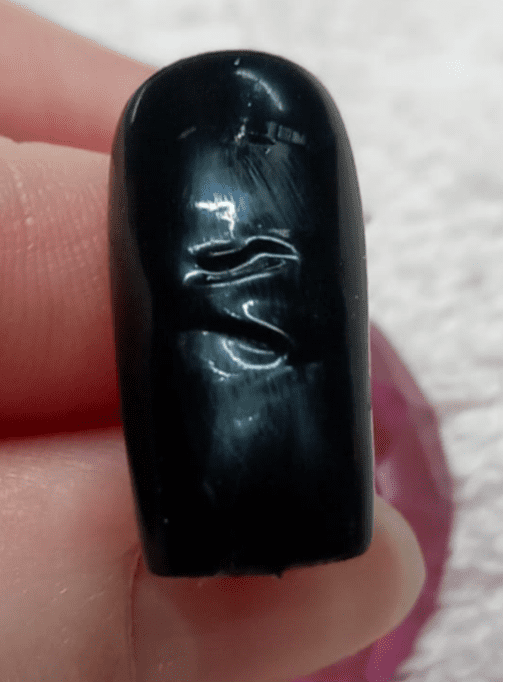
- O produto é aplicado com muita espessura
- A luz UV/LED não consegue penetrar na cor. Quando isso acontece, a camada superior do produto é curada, mas, como a energia UV não consegue penetrar mais profundamente, a metade inferior do produto permanece fluida.
- Apply 2 thin layers instead of 1 thick layer – don’t worry about blotching, the 2ndO casaco cobrirá isso.
- Check that your UV/LED lamp still works as well as it should. You can test this by placing some product on a form, curing it, then lifting it to see that the product is hard all the way through.
- A lâmpada UV/LED não é compatível com o produto
- Use a luz UV/LED adequada ao seu produto.
Your UV/LED light is one of the most critical pieces of equipment in your salon. Nanometers are everything when it comes to product cure but even the best UV energy has trouble penetrating thick, dark colors, leading to product lifting.
Um dos melhores investimentos que você faz é na lâmpada que combina com seu produto. O próximo melhor investimento é em suas próprias habilidades de controle do produto.
Descascamento ou lascamento:
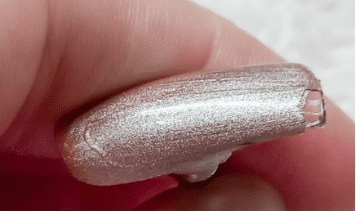
- O posicionamento da mão na lâmpada não é como deveria ser
- Check to see if the placement of your client’s hand is as it should be. Thumbs have always been a problem, but nowadays manufacturers create UV/LED lights with extra Light Emitting Diodes (the little lights) where the thumb should be.
- A placa ungueal não foi preparada adequadamente antes da aplicação do produto
- Às vezes, esquecemos de limpar a borda livre com nosso limpador. Também pode ser que haja algum pó de lima sob a borda livre. Reserve um minuto para virar a mão de cabeça para baixo antes da aplicação do produto, só para ter certeza. Quando sua cliente lavar as mãos com água e sabão antes do PEP ou PREP, dê a ela uma escova de unhas para limpar bem a borda livre. Seque bem e certifique-se de cobrir a borda livre não apenas com a camada de base, mas também com a cor.
Placas de pregos instáveis
- Lâmina ungueal muito fina
- Isso cria uma placa ungueal instável na borda livre, mas também um grande problema quando a unha cresce.
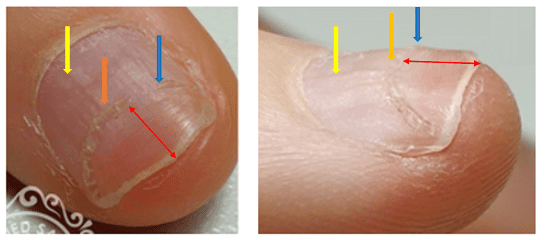
- Seta amarela: Uma crista normal na placa ungueal, não é bonita, mas podemos lidar com ela.
- Seta azul: Placa ungueal arrancada (as setas mostram a mesma posição em um ângulo diferente). O problema aqui não é apenas o fato de o produto se levantar, mas também o fato de estar desfiado. Também é possível levantar a bolsa aqui se colocarmos o produto nela agora.
- Seta laranja: Placa ungueal arrancada (as setas mostram a mesma posição em um ângulo diferente)
- Seta vermelha: A quantidade de placa ungueal preenchida e fina que precisa crescer antes que você possa fazer qualquer coisa com produtos para unhas artificiais.
Product lifting is almost guaranteed and worse still, this client probably wants these ugly nails covered so the look amazing even if they are not. Explain how you’re going to solve the problem and why putting product on this nail plate is not a smart thing to do. The chances of a nail plate infection caused by WSO or PA is waiting to happen and any product you do apply will likely lift. That would be a waste of your time and a waste of your client’s money.
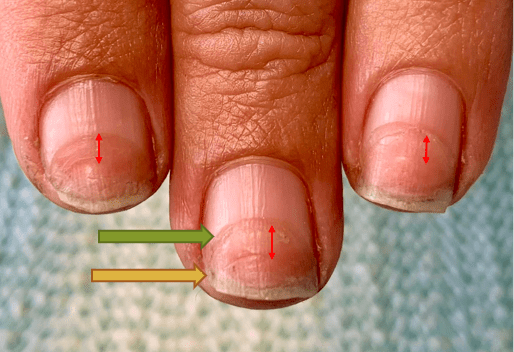
- Seta verde: Danos de arquivamento antigos crescendo
- Seta amarela: Dano de arquivo mais antigo crescendo
- Seta vermelha: A quantidade de tempo entre as manutenções das unhas é visível. Se essa placa ungueal cresce a uma taxa de 1 mm a cada 10 dias, então houve um intervalo de aproximadamente 25 dias entre as visitas ao salão de beleza.
Roedores de unhas
- A melhor coisa que você pode fazer por um mordedor de unhas é dar a ele um frasco de óleo para unhas e pele. Faça com que ele o use sempre que o dedo estiver na boca
- Nail biters only have minimal layers of nail plate left – remember the nail plate is in perpetual motion 24/7. If you have been to the seaside arcade with the penny machines that push the top coin into the drop tray – the nail plate cells work in the same way. Like an escalator in a store. Your product will always lift somewhere, and your client will always rip the rest off with their teeth.

The nails in Fig 5 took 11 months to treat with lots of quality oil & lotion. But now these nail plates are ready for any product or no product.
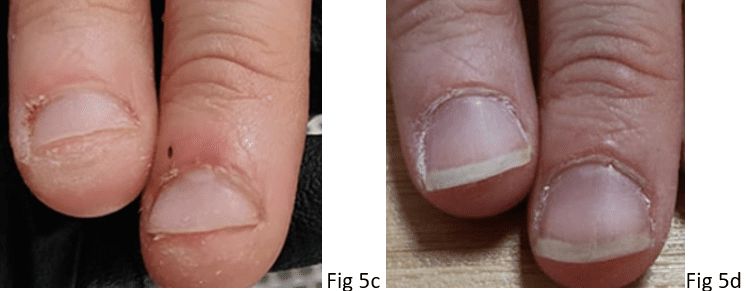
- Placa ungueal insuficiente para colocar o produto
- Os roedores de unhas não param de roer
- Fig. 5c: tentar colocar produtos para unhas em alguns milímetros da placa ungueal resultará em rasgos e em um trabalho de reparo interminável.
- Fig 5d: recovered nail plate ready for product, the client can still use more oil to help the proximal nail folds recover from keratinization, but the progress is obvious, now you won’t have a problem with product lifting, and the client can see the advantages of not biting 😊
Usar dicas em seu roedor de unhas:
I know a lot of nail techs do use tips on nail biting clients but try to resist the pressure, don’t be afraid he/she will go to another salon, explain the advantages of not doing it.
As pontas são uma ótima ferramenta no mundo das unhas, mas quando o roedor de unhas coloca os dentes embaixo delas, elas simplesmente as arrancam, o que causa ainda mais danos à unha natural que você está tentando deixar linda.
Tips need glue to adhere to the natural nail, glue contains cyano-acrylates that are allergens if they come into contact with the skin and the chances of that happening with 1/3 of a nail plate to work with is high.
Also, all that damaged stratum corneum around the proximal nail fold – nightmare for perfect product placement with lifting being the inevitable result.
Oil, oil, and more oil – give it 6 weeks then strut your nail stuff!
Remember – A temporary fix may look good for a day or 2 but is not a real fix. Solve the nail plate problem first and you will have a client in your salon for life.
Tamanho e ajuste incorretos das pontas das unhas artificiais
It’s important to choose the right size of tip for the nail of your client, but If in doubt use a flexible nail tip that is straight. Apply it only to the free edge of the nail (unless of course it’s a full cover tip – even then fit is really important).

If the tip is too big, you will create a flat C curve; if it’s too small, you will create a ‘staircase’ effect at the lateral nail fold and the free edge.
I’m going to keep this simple – Look for perfection training, all respectable brands have educators that do this.
Cola de ponta
Todas as colas ou resinas de ponta são feitas de ou contêm cianoacrilato de etila ou cianoacrilatos.
- Cyanoacrylates are a family of strong, fast-acting adhesives with industrial, medical, and household uses. They are derived from ethyl cyanoacrylate and related esters. The cyanoacrylate group in the monomer rapidly polymerizes in the presence of water to form long, strong chains. They have some minor toxicity.
- Ethyl cyanoacrylates are also used in forensics for lifting fingerprints when traditional fingerprint powder cannot be used, for instance on very delicate items. This happens in an enclosed chamber that is heated to allow the ethyl cyanoacrylate to turn into fumes and so show the hidden fingerprint.
- As colas de consumo prontas para uso não são adequadas para aplicações cosméticas ou médicas para mãos/pés, pois não são de grau cosmético ou médico, o que significa que suas formulações de solvente e cianoacrilato não foram avaliadas e otimizadas para reduzir a toxicidade e evitar reações alérgicas ou a corpos estranhos.
Basically, they are all super glues, and all contain allergens – Tenha muito cuidado para não deixá-los entrar em contato com a pele.
Ethyl cyanoacrylate and cyanoacrylates have a limited shelf life. Solvents are added to the mix to help the adhesive solidify quickly. When you open a bottle of nail tip adhesive the solvents are evaporating, and the quality of the adhesive will reduce very quickly. If you don’t use it often, buy smaller bottles of 5ml and that will reduce wastage and frustration.
Cola antiga
Nail glue has a limited shelf life. The older it gets, the less likely it is to form a sufficient bond to hold the nail tip in place. This affects its ‘stickiness’, and your nail tip extension will not last.
Também é importante lembrar que os adesivos de unha têm uma vida útil limitada, mesmo quando são novos. Esse é o motivo pelo qual você deve aplicar as pontas de unha somente na borda livre da unha, 2 mm = 2 semanas de crescimento para uma unha natural média.
A estrutura do produto para unhas artificiais é o que manterá o aprimoramento da extensão no lugar.
Depois de aplicar as pontas, não remova o excesso de pó com álcool ou limpador de unhas, pois isso acelerará a quebra do adesivo e/ou enfraquecerá a ponta de unha de plástico. É melhor simplesmente escová-la.
Se você não preparar a unha natural corretamente, sempre ocorrerá o levantamento da bolsa que, por sua vez, se tornará o local perfeito para a reprodução de patógenos residentes ou transitórios, como a pseudomonas aeruginosa.
Certifique-se de que sua cliente entenda que, com as extensões de pontas de unhas, ela sempre precisará usar luvas ao realizar qualquer tarefa que envolva outros solventes e/ou água. É por isso que as pontas de unhas não são ideais para clientes que trabalham em bares ou em outros setores de serviços.
Colocação incorreta do formulário
A colocação da forma é algo que você precisa praticar e aperfeiçoar. Depois de dominá-la, você nunca mais usará uma ponta de unha.
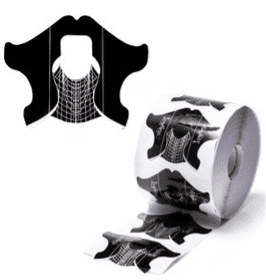
Forms have wings and lines. These are to ensure a perfect fit. Most brands have their own forms, all a little different in shape but all with the same goal in mind. Perfect form fitting creates a stable enhancement that fits the nail and the nail unit of your client. You can then place the artificial nail or extension with perfect alignment and balance.
Os problemas começam quando você começa com uma unha plana e não ajusta a forma para corresponder. A forma precisa se encaixar perfeitamente sob the free edge of the natural nail, and you should create the C-Curve with the nail product. (See Picture E) If you leave a gap (because you are trying to create the C-Curve with your form) and the nail product leaks through the gap, even water from something simple like your client taking a shower will cause the product to lift in a matter of hours. (See picture D)

If you start with a curved nail and the form does not properly fit, the product will not cure as well as it should. Apply the product in thinner layers, and cure according to the manufacturer’s instructions.
With practice you will achieve this – see picture E
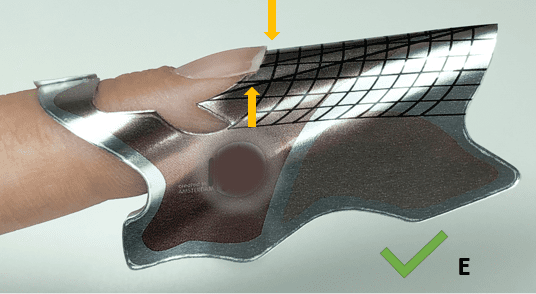
A aplicação da forma requer prática. Pergunte ao fornecedor da marca sobre o treinamento de perfeição e a colocação da forma. Quando você acertar, não terá problemas com o levantamento do produto nas dobras das unhas ou na borda livre.
Contato do produto com a pele durante a aplicação
As células da lâmina ungueal são formadas na matriz e seguem seu caminho ao longo do eponíquio (onde a cutícula está presa). Em seguida, elas saem sob o PNF, onde são vistas como a lâmina ungueal normal. (A figura F mostra essa ação em movimento)
Isso acontece 24 horas por dia, 7 dias por semana! Doenças ou gravidez podem desacelerar ou acelerar esse movimento.
If our product application is not as secure as it should be, maybe you’re in a hurry, maybe you didn’t bring your glasses to work or maybe the product you are using has a thin viscosity – the product might then drip into the lateral nail fold and become attached to your skin. (Figure G shows this)
Na MasterClass 1.2, você pode refrescar sua memória sobre esse assunto.
Let’s have a look at pictures F & G
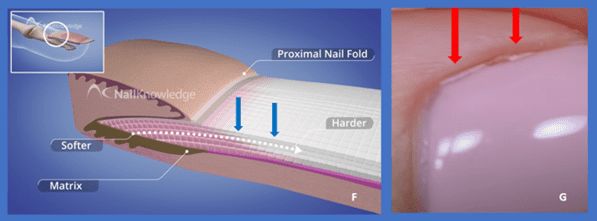
In picture F, you see 2 blue arrows; In picture G, two red arrows. So now imagine that they are in the same place in the lateral nail fold. F is in perpetual motion and G is static, the gel polish is hard and can only move with the nail plate. The gel polish that is in the nail grove will come loose and lift away, creating an opening. Water, oil, lotion, pathogens… Anything and everything can get between your gel polish and the nail plate! Product lifting will happen, and possibly an infection to boot!
É preciso muita prática para colocar o produto perfeitamente ao redor do PNF e das dobras laterais das unhas. Portanto, invista em si mesmo e dedique um tempo para aprender. Se você conseguir dominar as linhas retas com verniz para unhas, você se tornará um especialista em linhas retas com esmalte em gel. Dominar isso fará com que você seja mais eficiente no salão.
Proporção incorreta de mistura de líquido e pó (sistema de unhas de acrílico)
O monômero líquido e o pó acrílico combinados formam o sistema perfeito de aprimoramento de unhas. Uma vez dominado, é um produto realmente incrível.
Você pode usá-lo para:
- Reconstrução da unha do pé
- Reconstrução da placa ungueal
- Extensões
- Reequilíbrio
- It’s a reliable soak-off base for any system
- A camada de base perfeita para placas de unhas com sulcos
- Esculpindo a perfeição
- Endless possibilities in nail art
Ele tem desvantagens:
- Odores de monômeros líquidos
- A falta de ventilação pode causar coriza, nariz e dores de cabeça
- Too wet – can trigger allergies
- Too dry – your enhancement will not adhere well to the natural nail
- In the old days – it was hard to file
- Partículas finas de poeira
If you haven’t mastered L&P, product lifting becomes a problem.
Arquivamento excessivo
Basicamente, a aplicação desigual do L&P sempre resultará em elevação do produto ou da bolsa. Você deverá lixar até que fique uniforme. Eventualmente, a limagem através do realce é uma possibilidade real, e a limagem através da placa ungueal também.
Using an acrylic brush you are not in control of, and a product that is too dry, may leave ‘doorsteps’ at the PNF. (see the red arrow in picture L)
A lâmina ungueal no PNF é a mais macia e as células da lâmina ungueal precisam sobreviver intactas por 5 meses. O lixamento excessivo nesse local não só danificará o seu aumento, mas também a lâmina ungueal, e o produto se levantará. Da mesma forma, se a forma não se encaixar bem, a parede lateral do aumento não será forte (consulte a figura L, a seta amarela) e a borda livre será irregular e fraca (consulte a figura L, a seta laranja)

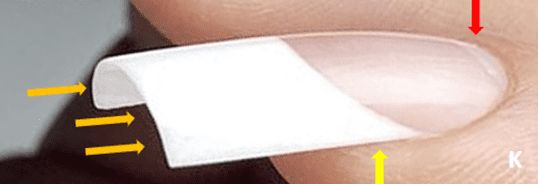
When the form is placed well and you have control of your L&P, you will not need to file excessively at the nail folds and your apex will be so strong the nail will last and last. (see figure K red, yellow and orange arrow)
Produto muito úmido
Se o cordão de L&P estiver muito úmido, o produto que escorrer para as dobras laterais da unha (como no exemplo do esmalte em gel na figura F) fará com que o L&P se levante. Como os sistemas de L&P secam ao ar livre em vez de curar em uma lâmpada, você tem mais tempo para puxar e segurar suavemente a pele nas dobras das unhas durante a colocação do produto e manter o controle do produto.
One more important reason for product lifting with L&P systems is shrinkage. L&P that is too wet will air dry at the wrong speed. When this happens, the excess monomer evaporates, the remaining polymer chains get pulled together, and the product tightens on the natural nail. This will not only cause pocket lifting that will be the perfect place for nasty pathogens, but it can actually be painful and heat will be generated by the chemical reaction caused by the polymers as they dry. Your client will experience this as uncomfortable pressure, maybe even intense heat hours later, and the enhancement will not last.
Practice, practice, a little patience, and lots of ‘bead making’ on practice sheets will ensure that you can create the perfect enhancement that will last longer than any other. A natural nail overlay with L&P will not only look stunning but, when placed well, it will wear as no other, and the rebalance will be done in 30mins.
Não usar o sistema correto para o tipo específico de unha
Let’s go back to figure F. Remember the nail plate cells and their movement?
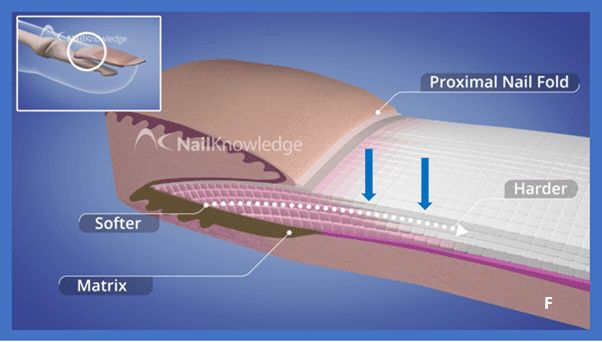
Marian Newman fala na Masterclass One sobre como a espessura da placa ungueal é determinada pelo comprimento da matriz. As células mais novas da lâmina ungueal são mais macias, não muito maduras, se você preferir.
Agora imagine que você tenha uma unha amarga, com placas de unhas finas para começar, que não resiste a mastigar o restante da placa ungueal. Não há nada de bom em colocar um produto de escultura duro nessa base muito fraca! O motivo pelo qual não vai dar certo é que a base (a placa ungueal) tem camadas incompletas mastigadas e está sempre em movimento. O levantamento da bolsa será inevitável, com todas as coisas desagradáveis que vêm com ele.
Uma placa ungueal fraca precisa de um produto flexível aplicado em uma camada fina (se you are going to use a product). I would recommend first recovering the nail biter’s nail plate before considering any product application. But, if you must, maybe for a wedding or a special occasion, use a clear fiber gel (figure J:)
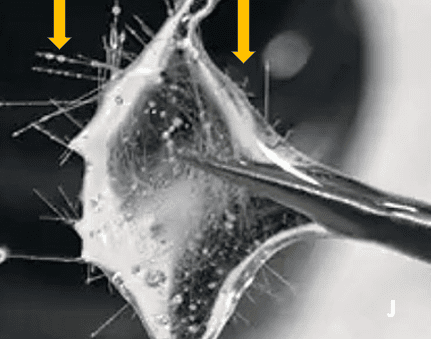
You can create simple small nails with a special effect nail varnish topcoat and your client will love you forever. He or she will have great looking nails with no problems, and you will be able to see through the product spotting any problems with lifting before things get out of hand. Get him or her to come back after the occasion – check that the nail coating is still intact, and no problems are occurring – if it’s not remove it!
O treinamento, bem como a manutenção das mãos e das unhas, é importante aqui.
Levantamento de bolso
- Trauma
- Beliscão
- Fraqueza da placa ungueal
- Infecções
Levantamento de produtosNo contexto dos cuidados com as unhas, refere-se à separação ou descolamento de produtos para unhas, como acrílico ou gel, da placa ungueal natural. Esse problema ocorre quando o produto aplicado na unha perde a aderência à unha natural, resultando em lacunas entre o produto e a unha natural ou até mesmo no descolamento total. O levantamento do produto pode ser causado por diferentes fatores, alguns dos quais podem ser causados (não intencionalmente) por nós mesmos.


Trauma
If you knock the enhancement or nail coating while shopping, or while cleaning (even if you are wearing gloves) then the impact can cause the product to lift, and you won’t always see it from the outside. This pocket of air between the enhancement & the nail plate creates the perfect place for opportunistic pathogens. The problem is that because we have created gorgeous nails we don’t always see on time whats going on underneath – so a good rule would be, when in doubt, if you know you have knocked your nail remove the product to check if and what damage has been done and repair it as soon as possible.
Levantamento de bolso
Pocket lifting occurs when the nail product separates from the nail plate but not around the edge. If you are wearing a clear product its visible but if you have created something amazing or using dark colors – you can miss it.
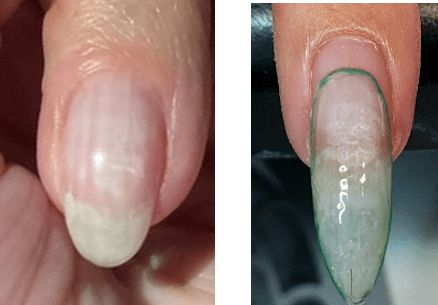
If it’s a natural overlay or a long extension – the result is the same, the nail enhancement is detached from the nail plate in the center – we can see it on the left nail because the enhancement is clear, on the right nail we only see it because we are rebalancing the enhancement.
Beliscão
‘Pinching’ is something we do in competition to create the perfect C-Curve, it needs to be done well and with care because if we ‘pinch’ an artificial nail product and the nail product is too hard, product lifting becomes a real possibility. 30 years ago, pinching was the ‘norm’ and in competition is still a useful tool if you have been trained well.
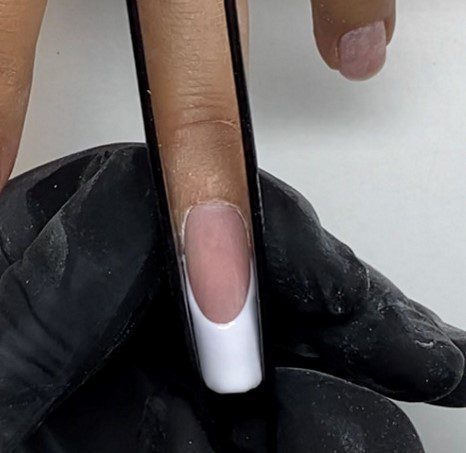
The C-Curve is pinched after product placement of the white to produce the perfect ‘C’ (This is done after the cover color is cured).
Today our products are more controllable and ‘building’ an apex and producing a C-Curve is easier if your colocação de formulários is well done but here also the rule is ‘product control is everything’ Done well you can produce gorgeous, long lasting nail extensions in the salon.
When you put the two side by side you see the difference but more importantly both effects are achieved without any pocket lifting – Product control, control of your pinching tool and good instructions are so important, you cannot achieve this kind of artificial nail without a good education and hours of training – but when you have mastered it, there is no looking back.
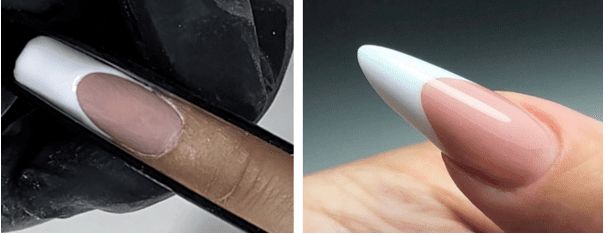
Instabilidade ou fraqueza da placa ungueal
If you ‘buff’ the natural nail before applying nail coatings of any sort, then, per definition, you are weakening the nail plate. If you also remove the skin from around the nail plate in the lateral nail folds & proximal nail fold, then you destabilize the entire nail plate. This creates an instability, a bit like building a house on sand instead of a solid foundation. Built on sand, the house will show signs of weakness or collapse, build on proper strong foundations the house will remain standing for as long as the building materials allow. The same is true for the nail plate when it ‘carries’ a nail coating. When the nail is intact and its surrounding seals are still in place the nail coating will remail attached to the nail plate for as long as the nail coating is made to last, if we remove any or all of the essential parts the nail plate becomes unstable and our nail coating will per definition become instable and weak.
Sometimes we get a little too enthusiastic when we are told to ‘remove the shine’ from our nail plate with a file. It’s better to think about replacing the buffer lixe com um bom limpador de placa ungueal. Seu produto aderirá bem à unha natural e a placa ungueal permanecerá forte. Lembre-se de que a placa ungueal tem, em média, apenas 0,380 mm de espessura. Não é necessário lixar muito para remover não apenas a camada superior, mas remover muito influenciará definitivamente sua estabilidade e convidará os agentes patogênicos a entrar!
Também é possível que você tenha aplicado um revestimento em uma unha que foi danificada por um roedor ou removedor de unhas, a base está instável e o revestimento da unha está vulnerável.
There are professional products on the market that create an ‘interpenetrating polymer network, em the nail plate. Strengthening the nail plate while maintaining a healthy flexibility is important, however, you should make a plan to completely recover the nail plate before applying any product at all. Care & maintenance with oil & lotion is essential but your client may want an ‘instant result’ and of course, we understand that, but sometimes taking a little more time to recover the nail unit first is better for you and your client. If you understand why its important to take a little time to recover the nail unit first, you can explain this to your client and he or she will love you for it.
For ‘special occasions’ its possible to create gorgeous nails that stay in place for the occasion but that can be easily removed so that nail plate recovery or nail maintenance can continue after the fact – Using ‘Full Cover Tips’ or ‘Press on Show Tips’ could be a temporary option if you place them with care & remove them in accordance with the manufacturer’s instructions.
Infecções
As infecções podem ocorrer com qualquer pessoa, a qualquer momento, seja você um técnico de unhas profissional ou amador, ou esteja fazendo suas próprias unhas, e as infecções dentro ou ao redor do local onde o produto foi levantado são simplesmente uma consequência do levantamento do produto.
We always have pathogens and microbiomes with us, they are a part of our normal daily life, most are essential to our wellbeing but sometimes, circumstances happen that create the perfect surroundings for them to allow their ‘nasty side’ to develop. Where your product is lifted from the natural nail becomes a cozy place for pseudomonas aeruginosa or WSO (white superficial onicomicose) to develop and cause a riot. The problem is we can’t always see this happening because they are developing underneath our nail coatings.
Se você perceber que algo causou um problema, talvez suspeite de uma infecção, remova o revestimento, limpe bem, use os protocolos de primeiros socorros, obtenha um diagnóstico e resolva o problema antes de reaplicar o produto.
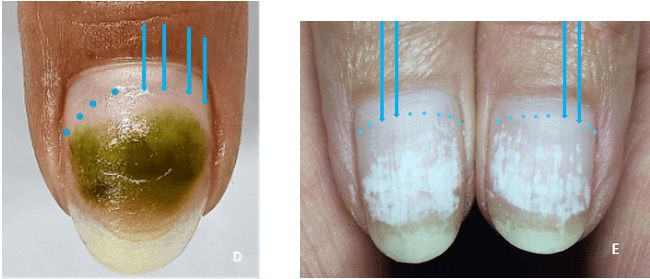
Fig D: Pseudomonas Aeruginosa after nail coating removal – the blue dots & arrows show where the edge of your nail coating was.
Fig E: White Superficial Onychomycosis after nail coating removal – again hidden under the nail coating.
Both of these infections are caused by our own body’s microbiome because we made it possible for them to develop. Hand & Nail maintenance with oil & lotion should be standard practice when artificial nail coatings or Nail Polish has been applied and we should be able to communicate this to our clients and to understand it ourselves whether we are DIY, students, or nail professionals – follow the same basic rules & the same hand & nail maintenance plan.
Placas ungueais afetadas pela hiperidrose
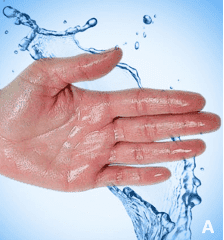
Excessive sweating or uncontrolled sweating (Palmer Hyperhidrosis) affects you’re the ‘cushioned’ part of your hands. Sweating occurs uncontrollably. Your hands may feel clammy or wet most of the time, it can happen at any temperature or during any season. The symptoms can increase in times of stress or anxiety. Socially it makes you feel uncomfortable shaking hands with someone, handing out papers at a meeting, or typing on a keyboard. Sweating happens without a trigger, not due to any external factor like exercising or an increase in body temperature. It can run in families, and it can be associated with other forms of hyperhidrosis or with certain medical conditions.
Isso pode afetar as placas ungueais porque a umidade excessiva formada no leito ungueal e ao redor da unha pode fazer com que a placa ungueal permaneça mole. Se sua cliente sofre de hiperidrose, isso pode ser uma contraindicação para a aplicação de revestimentos de unhas devido ao risco de criar as condições perfeitas para isso. Somente o verniz para unhas é recomendado.
Ref: 1. (veja o final da página)
Colocação de produto sob o PNF
Essa prática, sem saber onde o eponíquio começa ou termina (durante uma Arquivo eletrônico manicure), é irresponsável.
Abusing the nail unit’s guardian selos is not a part of a nail technician’s (legal) competencies. Should an infection occur, as a result, and your client or student chooses to sue you, means you will need to have good insurance.

Nail plate abrasion has taken place well behind where the PNF should be closed onto the nail plate, and the seals that protect the nail matrix from pathogens have been removed. If you proceed to place artificial nail product under the removed PNF and cure it in a UV/LED lamp, as many do… you are contributing to factors that could result in an acrylate allergy for your client.
O eponíquio não é visível do lado de fora da unidade ungueal. Portanto, você não tem ideia se causou danos ou não. Você também não sabe quanto produto foi curado sob a dobra deformada remanescente da unha. O produto pode simplesmente ser lavado ou voltar para a unidade ungueal.
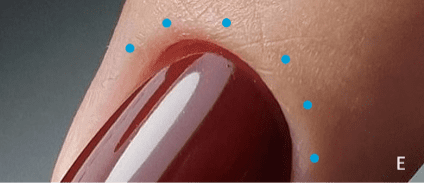
Soaking off product from nail units without guardian seals is a guaranteed way to invoke an acrylate allergy. Be very aware – By the time an allergy is recognized – it’s already too late.
Sistemas de mistura
Todos nós fazemos isso e todos nós já fizemos isso.
Mixing systems is fine if you are creating nail art for a Multimedia Tip Box Competition, assuming that you are working in a well-ventilated working area (as you should be). There is almost nothing more relaxing than doing that, especially if you have lots of unused nail stuff lying around. It’s a great way to use up all of it and maybe win a prize or 2 in the process. All good and all ok.
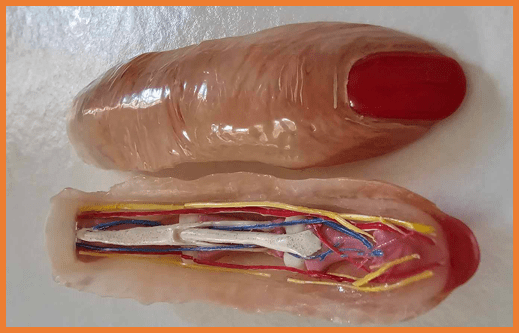
I’ve created some fingers for you, both the front and back sides. These practice nails are made from various artificial nail products, including leftovers such as acrygel, acrylic, paint, gel paint, nail glue, and plasti-love. These were never used on a client’s hand; they were just for fun. It’s a great way to make use of your surplus products and further develop your skills at home. 😊
But …
If you are creating gorgeous nails for a client that’s paying you money for the service, then you need to make sure that each layer of your enhancement is cured and layered as it should be. No matter if it is gel polish, acrygel, or acrylic.
Usar um primer ou um adesivo da marca A e, em seguida, uma camada de base da marca B, ou até mesmo um gel construtor com uma camada de base incorporada da marca B é pedir para ter problemas. Os dois produtos poderiam, em vez de serem combinados, ser adversos um ao outro.
Primer A – goes into the upper layer of the nail plate. The base coat of brand A then goes on the natural nail. The 2 products bind with each other and create the perfect fix on the natural nail.
Bonder B – lays on the natural nail, and cures in a UV/LED lamp. It then creates a sticky layer for the base coat of brand B to bind with, creating the perfect fix on the natural nail.
If you use primer A and combine it with the base coat of brand B – you are mixing chemicals and have no idea if it causes a problem or not until it’s too late. The product can lift, or it can even repel from the nail plate entirely. Worse still, it can create a reaction that may cause an allergy or a burning sensation for yourself or your client.
Os químicos criam nossos produtos para unhas artificiais com cuidado. Deixe a química com eles!
Todas as marcas devem ter um sistema que funcione desde o primer ou a cola até o topcoat.
Use the UV/LED light that belongs to the system you use – don’t risk under curing products!
Mixing them without knowledge is like putting diesel in a petrol motor car. You don’t know how much damage you do until it’s too late. Believe me, I know! I have done it and it was hilarious until I paid the bill for having the diesel removed and my engine cleaned!
- An Bras Dermatol. 2016 Nov-Dec; 91(6): 716–725. Hiperidrose palmar: aspectos clínicos, fisiopatológicos, diagnósticos e terapêuticos*
Flávio Ramalho Romero,1 Gabriela Roncada Haddad,1 Hélio Amante Miot,1 e Daniele Cristina Cataneo1

